26 Nov How to use essential oils to mitigate the risks of respiratory colibacilosis

The avian respiratory system has a unique structure that provides the birds the most efficient respiration among all terrestrial vertebrates. It is essential to allow flight, a highly energetic activity that requires a fast metabolism together with a remarkably effective oxygen supply. The respiratory system in birds consists of a paired static lungs, where the gas exchange happens, and connected air sacs that expand and contract, moving the air through the lungs.
As we explained in this post, the air flow in birds is unidirectional, meaning that the air moving through the lungs is always fresh, making more oxygen available to diffuse into blood. In contrast, the air flow in mammals is bidirectional, mammalian lungs contain a mixture of fresh and old air, with less oxygen available.
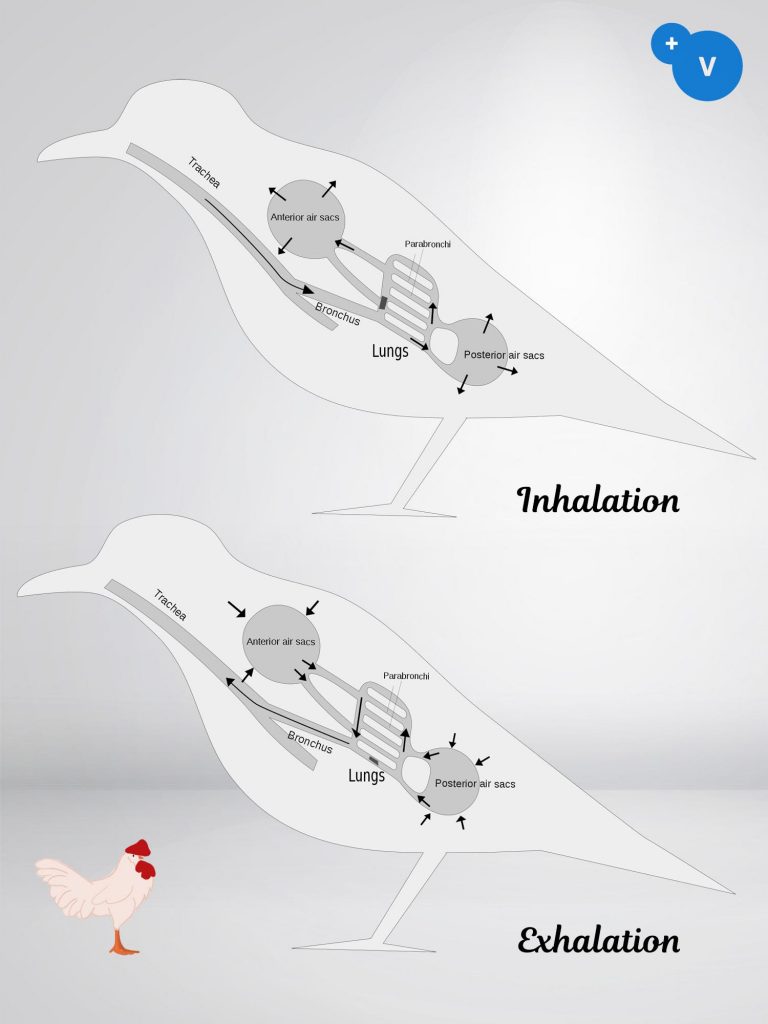
The special anatomy of the avian respiratory tract makes respiration extremely efficient but at the same time increases bird’s exposure to airborne pathogens:
- The air sacs fill a large area of the chest and abdominal cavity. During inhalation, part of the incoming air flows directly into the posterior air sacs. The incoming air may carry microorganisms, including Avian Pathogenic Escherichia Coli (APEC) and air sacs do not have a robust local immune system to fight these incoming pathogens. For this reason, respiratory colibacilosis is so common in modern poultry farming.
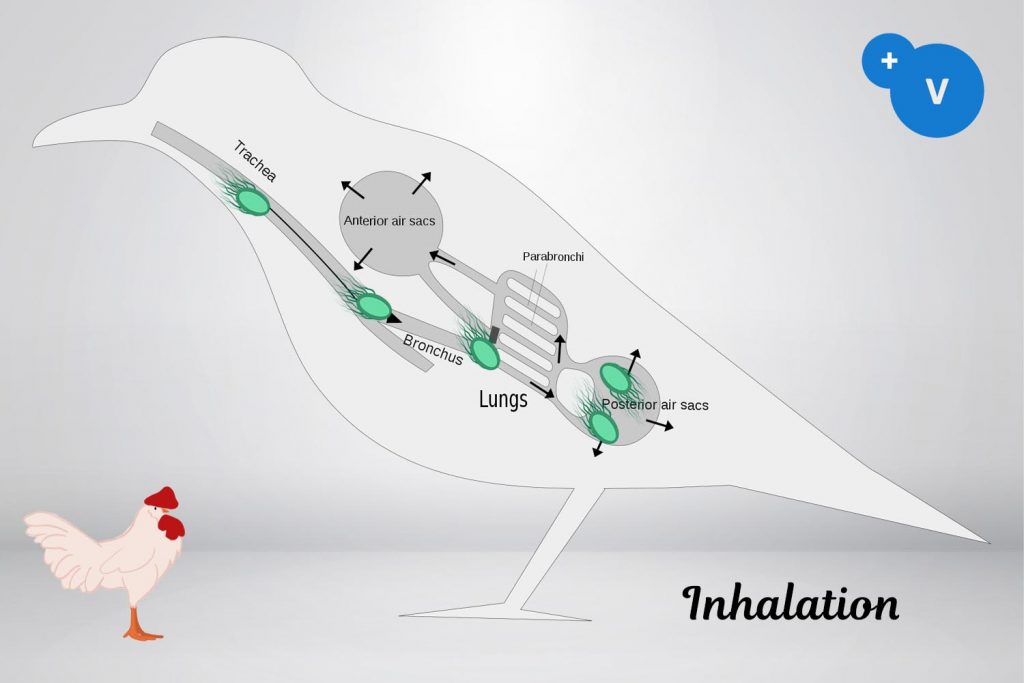
- The gas exchange is the process of oxygen delivery from the lungs to the bloodstream and the elimination of carbon dioxide from the bloodstream to the lungs. The gas exchange membranes are thinner in avian lungs than in mammals’. A thinner interface makes gas exchange more efficient, but at the same time it is easier for airborne pathogens to cross the membranes, enter the bloodstream and start localized or systemic infections.
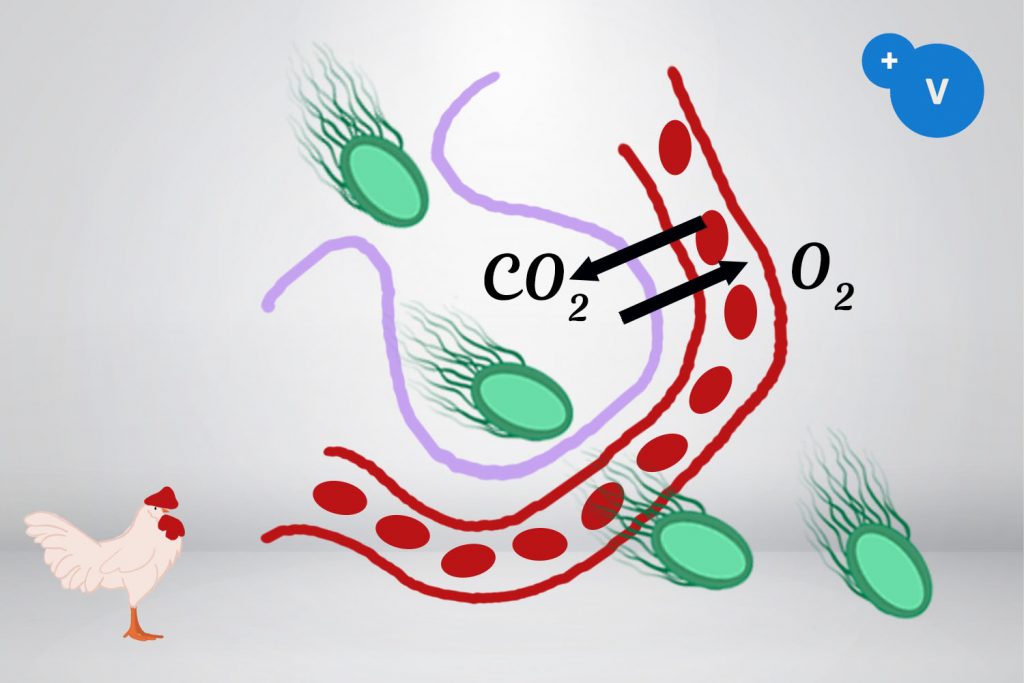
Predisposing factors for respiratory infections by Avian Pathogenic Escherichia Coli
The inhalation of contaminated dust is the main cause of respiratory infections by APEC: dust may contain 106 CFU of E. coli per gram. However, as we explained in the first article of this series, in despite of the bacterial load of dust, colibacilosis happens only when the birds are debilitated, so respiratory infections by APEC take place after a respiratory stress that damages the natural defense mechanisms, in example:
- A concentrations of ammonia in the house higher than 10 ppm, because it impairs the movement of the respiratory cilia
- Respiratory infections by Mycoplasma gallisepticum, Pasteurella multocida or virus (IBV, NDV), that start a immune response and damage the respiratory cilia
- Suboptimal environmental temperature or moisture
- Secondary reactions to live vaccines. On one hand live vaccines may induce a mild immunosuppression and, on the other hand, live virus from the vaccine can replicate in the respiratory tract and damage the cilia
Generally speaking, any agent that lowers the activity of the immune system, induces an overproduction of mucus, damages the respiratory mucosa or impairs the function of the respiratory cilia is considered a risk factor for respiratory colibacilosis. More information about the key role of respiratory cilia here.
Respiratory infections with Avian Pathogenic Escherichia Coli involved
Avian Pathogenic Escherichia Coli can cause respiratory infections by itself in immunocompromised or stressed animals (colisepticemia) or occur together with other bacteria, fungi or viruses (Chronic Respiratory Disease, Swollen Head Syndrome).
Colisepticemia
Colisepticemia is the most widespread infectious disease in commercial poultry operations.
During the development of colisepticemia, APEC firstly colonizes the trachea and the air sacs, secondly penetrates the respiratory epithelium or the gas exchange membranes and finally reaches the blood stream and causes septicemia (bacterial infection of the blood).
Affected animals show airsacculitis, pericarditis and perihepatitis, with the presence of yellowish exudates made of fibrin and pus. The infection of the heart may lead to cardiac failure. The infection may spread to other organs and lead to peritonitis, salpingitis, synovitis or arthritis.
Respiratory infections with Avian Pathogenic Escherichia Coli involved
Avian Pathogenic Escherichia Coli can cause respiratory infections by itself in immunocompromised or stressed animals (colisepticemia) or occur together with other bacteria, fungi or viruses (Chronic Respiratory Disease, Swollen Head Syndrome).
Colisepticemia
Colisepticemia is the most widespread infectious disease in commercial poultry operations.
During the development of colisepticemia, APEC firstly colonizes the trachea and the air sacs, secondly penetrates the respiratory epithelium or the gas exchange membranes and finally reaches the blood stream and causes septicemia (bacterial infection of the blood).
Affected animals show airsacculitis, pericarditis and perihepatitis, with the presence of yellowish exudates made of fibrin and pus. The infection of the heart may lead to cardiac failure. The infection may spread to other organs and lead to peritonitis, salpingitis, synovitis or arthritis.
Infection happens mainly due to inhalation of contaminated dust, as described above, but it can also start as a result of a digestive or navel infection, vertical transmission or after the intake of contaminated feed or water. More information n the routes of transmission of APEC here.
Colisepticemia affects poultry of all ages. It causes depression, fever, respiratory signs such as coughing or sneezing and poor growth. Mortality ranges from 5 to 20%.
It is treated with antibiotics, but APEC strains are becoming increasingly resistant to drugs.
Chronic respiratory disease (CRD)
Chronic respiratory disease (CRD) is a common disease of the upper respiratory tract. It is caused by Mycoplasma gallisepticum. CRD develops slowly in the flocks, causing progressive and chronic respiratory signs such as airsacculitis, tracheitis, sinusitis, nasal discharge, sneezing, gaping, and coughing.
Secondary infection by APEC further complicates the outcome of the disease and may lead to severe losses.
Swollen head syndrome
Swollen head syndrome is an acute, highly contagious infection of the upper respiratory tract. The main causative agent is a avian pneumovirus. APEC is involved in secondary infections.
Swollen head syndrome affects mainly broilers after the 4th week of age and broiler breeders around the peak of laying.
Affected animals show respiratory signs like sneezing and coughing followed by conjunctivitis and swelling of the head. Mortality ranges from 1 to 10%.
Use of essential oils to reduce the risks of respiratory colibacilosis
Essential oils are part of a holistic plan to prevent respiratory diseases caused by APEC.
Essential oils contribute to a safer farm environment
Certain essential oils inhibit the growth of fecal bacteria that are involved in transforming proteins into ammonia. When administered through drinking water, these essential oils help to keep environmental ammonia levels under control. More information here.
On the other hand, essential oils can be sprayed in the environment of the farm and reduce the amount of E. coli present in the dust and in the surfaces, as we demonstrated in this experiment.
Essential oils optimize the functioning of the respiratory system
As we have explained above, the functioning of the respiratory cilia is key to prevent the arrival of APEC into the posterior air sacs. Certain essential oils speed up the ciliary beat frequency up to 20%, improving the physiological cleaning up of the respiratory airways. Essential oils are can also protect the integrity of respiratory cilia in the presence of pathogens such as Mycoplasma gallisepticum and respiratory virus.
On the other hand, the administration of essential oils enhances the functioning of the immune system (activity of immune cells, antibody production).
Essential oils reduce infections by E. coli and Mycoplasma
We demonstrated that essential oils are effective against Mycoplasma gallisepticum and E. coli in vitro.
More importantly, in farms with a history of respiratory diseases, the inclusion of essential oils in routine health programs reduces mortality, increases meat production, and boosts economic benefits.
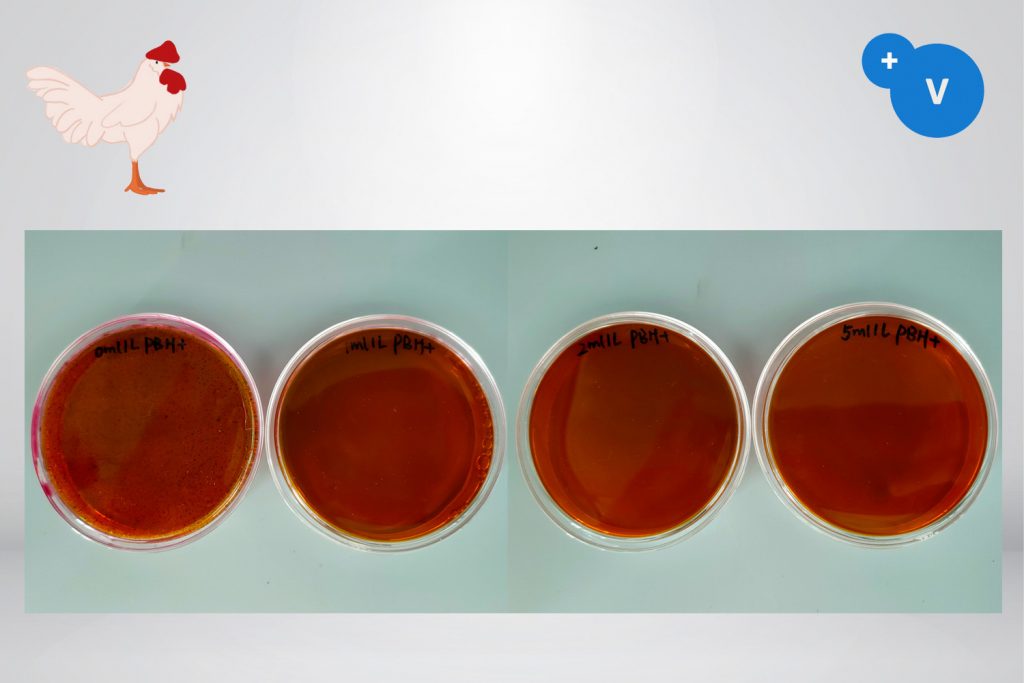
Antimicrobial effect of PlusBreathe at 0, 1, 2, 3, 5 ml/L against E. coli in EMB Agar. PlusBreathe completely inhibits the growth of E. coli starting from 1 ml/L. Trial made in our laboratory, July 2020
Essential oils are helpful during respiratory infections
Certain essential oils have natural antistress, antioxidant, anti-inflammatory, mucolytic and expectorant properties . They give a pleasant refreshing feeling to the animals, promoting feed and water intake.
In animals affected by respiratory infections, given together with pharmacological treatments, essential oils promote recovery, easy breathing, stimulate feed intake and reduce mortality.
On the other hand, given after vaccinations with live vaccines, essential oils reduce the secondary reactions, such as respiratory signs, increase of feed intake, and reduce the occurrence secondary infections by pathogens such as Mycoplasma gallisepticum.
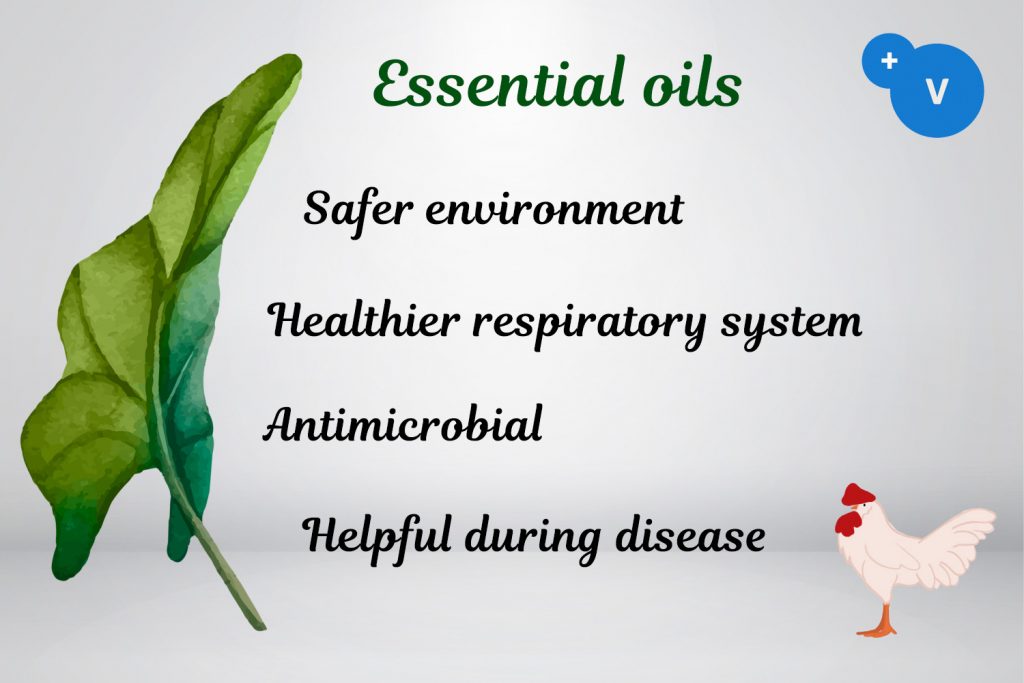
Tips for the prevention of respiratory colibacilosis
- Prevent the accumulation of dust in the house
- Prevent the formation of dust clouds when sweeping or cleaning with the animals still inside the house
- Use a litter disinfectant if animals are raised on the floor
- Strengthen cleaning and disinfection between flocks
- Monitor ammonia levels in the environment
- Optimize environmental moisture, temperature, and ventilation
- Protect the animal against Mycoplasma gallisepticum and virus through proper vaccinations. Raise mycoplasma-free birds
- Monitor for respiratory signs every day
More suggestions can be found in this article.
Products of choice
and pigs of all ages. It contains:
- Buffered organic acids, which reduce the pH of the water and inhibit the growth of Gram-negative bacteria.
- Monoester fatty acids, also called medium chain fatty acids, which inhibit the growth of Gram-negative and Gram-positive bacteria. In addition, they have antiviral effects.
- Essential oils and phytochemicals with antibacterial, antifungal, antiviral and antioxidant properties.
DigestoCid© has a broader spectrum of action than products based solely on organic acids, allowing superior antibacterial and antifungal efficacy at a less acidic pH (5.5-6.5).
PlusBreathe© contains essential oils with natural antiseptic, antioxidant, expectorant and mucolytic activity. It has a refreshing taste.
It is indicated to improve the functioning of the respiratory system and to mitigate heat stress in birds, ruminants, pigs and rabbits of all ages. It can also be nebulized in the farm environment.
Picture of the leaf found in Freepik.com

Certain health statements may not be applicable in your region.

